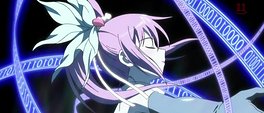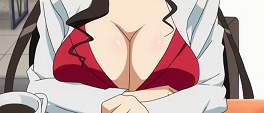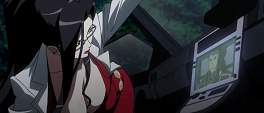



Kiddy Grade has had a troubled upbringing: originally aired in 2002 by a still vaguely respectable Gonzo, it was an unremarkable series until past the half-way point when it briefly became excellent then dipped back down to a simmering mediocre. Notable only insofar that it was directed by Keiji Gotoh who also did the superb Martian Successor Nadesico, apart from the enduring appeal of its numerous racy promo images it sank without a trace. Four years later a sequel was announced and a teaser released shortly afterwards; the full product failed to materialise until almost two years after that with Kiddy Girl-and. The wait hasn't been particularly unbearable, it has however been long enough to forget the minutiae of the first series.
A plot strapped to this ship will only expedite its sinking
All semblance of plot, characters and sense are thrown out the window leaving a colourful, high-pitched husk of a series. The lead character is nauseatingly upbeat and with a voice that sounds like a cat attacking a chalkboard, a sonic assault that is worsened by the insipid plot lines of the first three episodes. From breaking into a "high security" area to secure some dessert to a tedious argument between partners, it feels like a regression to a neolithic phase of storytelling: all cudgels and grunts with a total lack of subtlety. That it features an underwear plot in the first episode (something the seminal My-HiME waited for the fourth episode for) and a bath scene in the opening minutes of the second demonstrates just how keen this series is to attract viewers.
Read the rest of this entry




There are many good panty episodes in anime: episode four of Mai-HiME springs to mind as one, episode three of Yoku wakaru gendai mahou is not. Whereas the former had comic timing well beyond what one would have expected its studio to be able to produce, the latter is tawdry, boring tripe and is just the crowning achievement of an another muddled and bland instalment in the chicks-with-sticks and magic genre.
arcane magic of the hand-waving, runic variety and the "modern" magic of binary and cellphones
The series opens strongly with a battle against a sharply dressed wizard by two small girls who promptly get pummelled; rewinding six hours, the viewer is then treated to the first (and likely not the last) exposure of a criminally underage girl's posterior - while being chased by the impossibly sedate antagonist and engaging in some cryptic dialogue with other notable cast members. The public display of flesh is uncomfortable viewing, not only for the implied age of the participant but the futility of its inclusion - lacking any development of characters or story, it borders on pornography. From this low starting point, the first three episodes stumble haphazardly around like a late-night drunkard: first episode events are neither explained or explored and it's only upon reflection that the upcoming twist is made obvious. Elsewhere, characters who were no more than bystanders are now learning magic with the protagonist while incidents are nothing more than contrivances for character collisions. All of this set to a constant barrage of camera angles designed to place the poorly drawn breasts of the more well endowed females front-and-centre.
Read the rest of this entry




Or to give its full, punctuated title: Princess Lover! The premise - once again - is to cram as many lithe, buxom females into as confined a space as possible and provide an empty husk of a male protagonist to catalyse their frequently outlandish but never overtly raunchy interactions. In short: fan-service romance comedy. The anime is just one of a number of media co-minglings, starting with the visual novel by newcomers Ricotta (as in the cheese) and followed by light novels, manga, this anime and a related radio show. What should be surprising is just how many different ways such a vapid and paper-thin plot can be told.
this is borderline misogynistic, reinforced by the profusion of quantum singularities where underwear should be
The lead character's parents are killed and while moping near their grave one day he gets embroiled in a scrappily animated chase between a horse drawn carriage and an open-topped jeep full of thugs. One tenuous event leads to another and the pink haired, well-endowed passenger is flung from a cliff into a thicket of trees where upon the protagonist wakes up and finds himself fondling her chest. This is all immaterial of course because he has been adopted by his immeasurably wealthy grandfather, ostensibly in order to find the people responsible for his parent's murder and subsequently avenge them. Instead though he spends time rubbing elbows with various females and partaking in the local school social club (by attending a party after etiquette lessons, naturally). That this feels so familiar is odd considering the set-up at least is superficially unique.
Read the rest of this entry




Bright, colourful and full of barely concealed nudity, Umisho is a raucous and energetic series built upon simple principles that are well executed. Far from being intelligent, thought-provoking or in-depth, each episode kicks meaningful story-telling and character development to the curb and manages to be a thirteen episode onsen and beach scenario combined.
Umisho never belittles the audience by repeatedly hammering at the most obvious of plot points
Beginning with the only iota of character justification in the entirety of the show, Kaname Okimura joined the school swimming club to learn how to swim after a run-in with a supposed mermaid and nearly drowning in his earlier years. With that pesky plot out of the way, the series gets down to basics and has young women losing their clothing at every available opportunity. Ostensibly the series follows the swimming team of Prefectoral Umineko Shougyou High as they compete and subsequently win local and regional tournaments; however this is mostly superfluous to the aforementioned nudity. Not one to be entirely sexist, the swim team captain is a bronzed, muscled specimen of a man who strips off with more frequency than the women although this stems from his naturist tendencies rather than the women who are ordinarily victims of circumstance.
Read the rest of this entry




Dragonaut's first episode is full of breasts. The second episode is full of dragons. The third episode has breasts and dragons. This is of course entirely unsurprising given the character designer's previous works: Love Hina, Gravion and recently Witchblade; the seminal Stellvia of the Universe seemingly an exception to Makoto Uno's otherwise top-heavy résumé. Abnormally buoyant female appendages aside, Dragonaut's opening episodes are filled with confusing events, terrible CG wyrms and a slow-but-steady introduction to the cold-clinical world the series inhabits.
supposed secret labs and bustling command centres are rendered with a yawn rather than any flair
"Competent" is the best way to describe the series. It bears all the hallmarks of a two season show that isn't prepared to tip its hand at the outset. The hook centres on a trio of creatures that came to earth from outer-space, destroying the protagonist's spacecraft and family along the way. Modi operandi set, time jumps several years into the future when Earth is threatened, people actualise/synchronise/ride mechanical dragons and the once young protagonist now has a barrel full of angst to carry around. Terminology such as "Album", "Dragonaut", "D-Project" and "ISDA" are scattered liberally throughout the dialogue to inject a kind of faux mysticism to the proceedings but fundamentally, nothing is meritorious.
Read the rest of this entry



















